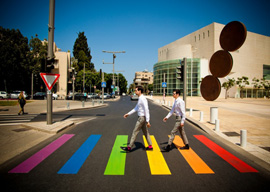
February 13, 2013

Added to this is the revenue that comes from heightened local business activity. All the boutiques, European-style hotels, bars, and restaurants will yield millions in sales tax and provide a virtually recession-proof economic environment. And everything will be accomplished without expropriating any real estate, destroying the habitat of endangered species, or polluting the environment. Purely in economic terms, if given a choice between a large gay district and, say, a giant Japanese manufacturing facility that would demand huge tax concessions, the local developmental agency would be crazy to choose the latter.
Compared to the old and futile Edifice Complex solution, the gaying of urban blight is simple and can be implemented without all the expensive, time-consuming consulting companies, EPA impact studies, planning commissions, begging Congress for handouts, selling urban development bonds, and all the rest.
How, then, must a city proceed in luring this great natural resource of gays? Start with the arts. Not some multi-million-dollar cultural center, but artists. With a relatively modest investment”less than $100,000 to begin”it could lure a few artistic types in fields such as modern dance, classical ballet, fashion design, and experimental theater. It is the public commitment that counts”the word has to get out that a city is serious about becoming an avant-garde artistic center. The cost of one ugly downtown parking ramp could fund a year’s worth of poetry readings, mime troupes, experimental music workshops, and many other activities sure to attract prominent gays and, critically, their wealthy heterosexual camp followers who adore being associated with fashionable art.
It is especially important that local government and the police maintain a “hands-off” policy during this early incubation period. Initial nurturing will be delicate”an ill-advised bar raid or a sarcastic remark about an over-the-top Halloween party could nip economic revival in the bud.
Eventually the strategy will begin to pay off. Hole-in-the-wall art galleries will spring up, white elephant old houses will become quaint bed and breakfast Victorian-themed inns, abandoned warehouses will morph into antique malls, and all sorts of tourist-drawing exotic establishments will take root. The annual Bette Davis Film Festival will draw thousands of upscale visitors.
Within two or three years downtown rents will triple, weekend parking spaces will be a rarity, and all sorts of yuppies will flock to all the boutiques, trendy restaurants, and a promenade filled with local eccentrics. (Think Key West’s Mallory Pier.) Famous artists and entertainers will buy and painstakingly restore tourist attraction homes. Busloads of Japanese and elderly may even begin showing up on the lookout for celebrities rumored to shop in the local Alexander McQueen store.
Skeptics may insist that while this solution may work in some places, it will fail in cities plagued by crime”gays will be easy targets for flash mobs, muggers, and street gangs. Yes, rolling queers may have been popular when victims would not go to the cops, but the New World Order has changed everything. Gays are now a protected species and any hate crime (and mugging a gay is automatically a hate crime) would never be tolerated. The local predators would quickly learn that gays are off-limits, not worth the risk and, ironically, many heterosexuals might decide to live in gay enclaves for self-protection. (Thriving commerce also helps reduce crime.)
But are there enough gays to populate all the cities needing economic uplift? Technically the answer is “no,” but this shortage is curable. Two factors permit the “stretching” of gays to assist dozens of needy cities. First, as the beneficial aspects of a gay population take hold, rents rise and at some point, the original gay pioneers are displaced. So like migratory birds, they move on and work their economic magic elsewhere. (Think San Francisco’s famous Castro District, once a dreary working-class neighborhood made gay-friendly by cheap rent.) Second, gay-friendly areas can become unfriendly and, again, like migratory birds they relocated to more hospitable settings. This is what is currently happening with many gays in Miami Beach’s South Beach“an uptick in anti-gay violence has lead to an exodus to (lucky) Ft. Lauderdale.
In the end, ironically, many of the local business boosters will never know what hit them when the benefits of gay life arrive. The Edifice Complex is not easily cured. To these stuck-in-the-mud civic boosters the city wasted its money when it paid $50,000 for the cutting-edge Merce Cunningham ballet troupe to spend six months mentoring local high-school students. They have no understanding of why sponsoring the female impersonator Liz Taylor lookalike bash has to be a regular line item on the municipal budget. In the meantime, everybody in the know will celebrate economics not as the dismal science, but as the gay science.